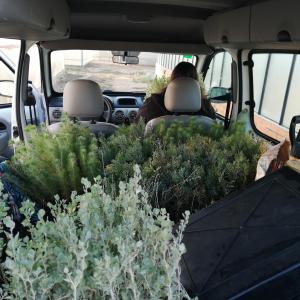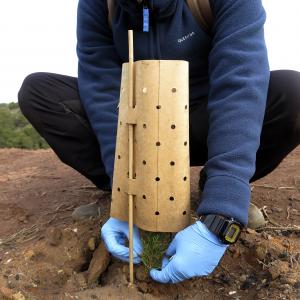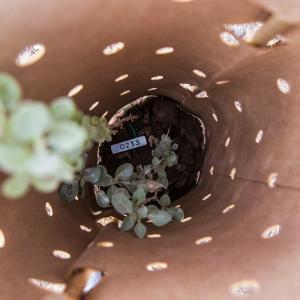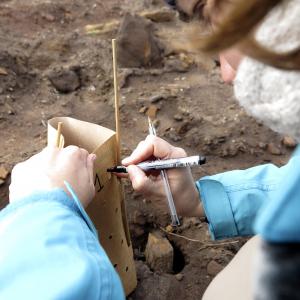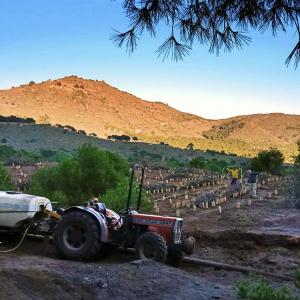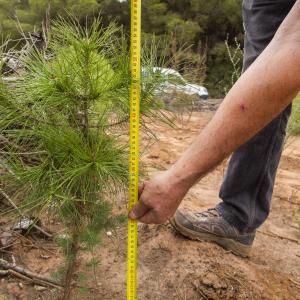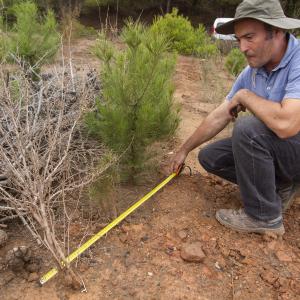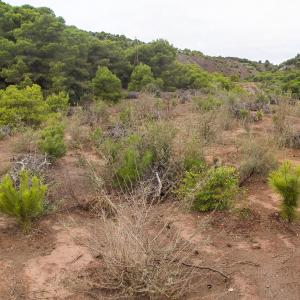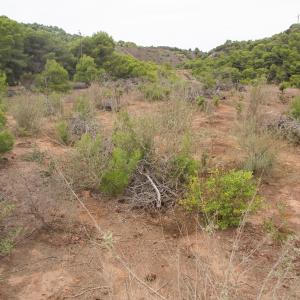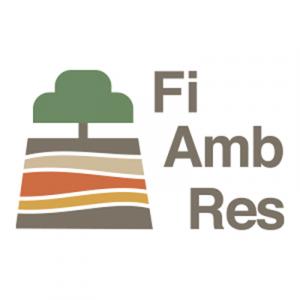

97.750 €. Project PDC2021-121383-I00 financed by MCIN/AEI/10.13039/501100011033 and the European Union Next GenerationEU/ PRTR.
Two and a half years: Dec 2021-May 2024
Entidad responsable UPCT.
Companies involved:
Ingeniería del Entorno Natural (https://entornonatural.org/)
Fundación Sierra Minera (https://fundacionsierraminera.org/)
Biocyma (http://biocyma.com/)
The general objective of this proposal is to valorize and transfer phytomanagement techniques, including the use of amendments from organic wastes, for the restoration of abandoned mining tailing piles in semiarid environments, based on the scientific results obtained in the CGL2016-80981-R project.
Mine tailings piles (left over from mining refining operations) store waste from ore processing and are considered the main responsible for the environmental problems in former metal mining areas. Due to the large number of abandoned piles, public authorities must prioritize actions in those that pose an unacceptable risk and where urgent action is necessary due to the collapsing risk and/or proximity to cities. These types of actions are much expensive, since they involve a high technical-engineering
component, either by relocating the mining piles or by its stabilization, sealing and covering them in situ. However, piles with tolerable risks, even if they do not pose an immediate high risk, are a source of potentially toxic elements to the environment in the short, medium and long term (chemical time bomb). This negatively affects the environment and human health and wellbeing. The economic unfeasibility of assuming the engineering restoration of the whole set of abandoned piles that remain in old mining areas, makes it necessary to look for alternative measures-applications that may complement the engineering restoration options.
A pilot demonstration area of about 2500 m2 in an abandoned mine tailing pile will be selected, in the former Cartagena-La Unión mining district. The three-specific scientific-technical objectives are: 1) to establish a stable vegetation cover by combining sowing and planting of adapted species to the stressful/limiting edaphic factors of the mining piles. Species selection will aim to increase vegetation cover in the short term by introducing tolerant species in specific edaphic niches; 2) to establish the basis for the development of fertility islands by introducing facilitator plant species. Due to their less competitive capacity, they will be located in areas where a lower sowing/planting density of fast-growing species is established, in order to reduce competition; 3) to accelerate the process of establishing the vegetation cover by applying biochar/compost type amendments, installing facilitator structures such as fascines and placing bird perches to contribute to seed dispersal. The final aim is to transfer the knowledge obtained and the technologies used to the public authorities and interested private companies in order to provide them with a useful tool that will help them to optimize the available resources for restoring mine tailing piles. A scientific-technical guide book for the implementation of the applied techniques, which will include a list of indicators to evaluate the success of the actions carried out, will compile the obtained results.
SCIENTIFIC PAPERS
Conesa, H.M., Franco, J.A., Ceacero‑Moreno, M., Martínez‑Sánchez, J.J., González‑Alcaraz, M.N., Álvarez‑Rogel, J. 2025. Response of field-grown native plant species to a combined amendment for phytomanaging metal(loid)-mine tailings. Plant Soil, November 2025. https://doi.org/10.1007/s11104-025-08084-0
BOOK CHAPTERS
Juan José Martínez-Sánchez, Héctor Miguel Conesa Alcaraz, María Nazaret González-Alcaraz, José Antonio Franco Leehmuis, Matías Ceacero-Moreno, José Álvarez-Rogel. 2024. Experiencias previas en la restauración de la Sierra Minera. Preparación del suelo y enmiendas (proyecto FiAmbRes). En: Remediación y restauración ecológica de emplazamientos de gradados por la minería. Marco de Actuaciones Prioritarias para recuperar el Mar Menor. Ministerio para la Transición Ecológica y el Reto Demográfico, Madrid. pp. 130-145. https://www.miteco.gob.es/content/dam/miteco/es/biodiversidad/publicaciones/restauracion/restauracion-ecologica-mineria.pdf
BOOKS
Álvarez-Rogel, J., Martínez-Sánchez, J.J., Conesa, HM., Leehmuis, J.A., Ceacero-Moreno, M., González-Alcaraz, M.N. 2024. Guía de aplicación de técnicas de fitomanejo para la restauración ambiental de depósitos de residuos mineros metalíferos en zonas semiáridas. EDITORIAL: Ediciones UPCT, 139 p. ISBN: 978-84-17853-79-2. Cartagena. https://repositorio.upct.es/entities/publication/cc1b3c07-5aad-47d9-9591-4d08e4575d84
PRESS NEWS
Noticias de la UPCT: Técnicas de fitomanejo logran que especies autóctonas fijen el suelo de un depósito minero de la Peña del Águila
Murcia Diario.com Técnicas de fitomanejo logran que especies autóctonas fijen el suelo de un depósito minero de la Peña del Águila
Agrodiario: Investigadores de la UPCT logran fijar suelo minero contaminado empleando plantas autóctonas
CARTAGENA ACTUALIDAD: Técnicas de fitomanejo logran que especies autóctonas fijen el suelo de un depósito minero de la Peña del Águila
cadenaser.com Pinos, cipreses y otras especies autóctonas crecen a gran velocidad sobre residuos mineros en la Sierra Cartagena-La Unión
CARTAGENA DE HOY: Logran que especies autóctonas fijen el suelo de un depósito minero de la Peña del Águila
Murcia Actualidad.com. Técnicas de fitomanejo logran que especies autóctonas fijen el suelo de un depósito minero de la Peña del Águila
WORKS IN PROGRESS
Between December 2021 and January 2022, soil tilling and amending (with a mixture of municipal solid waste and biochar) has finished on the 2,500 m2 pilot plot, located on an abandoned mining tailing in the Regional Park of Calbalque, Monte de las Cenizas y Peña del Águila. This has been authorised by the landowner, Francisco Fuentes Narváez, and by the Directorate General for the Natural Environment of the CARM.
Forty-four fascines have been located to provide shaded areas, refuges for fauna, organic matter and retention of sediment and plant propagules. In addition, several banks have been installed at the head of the gullies to reduce their advance by dissipating the energy of runoff water and contributing to sediment retention.
A total of 742 plants of Pinus halepensis, Tetraclinis articulata, Atripex halimus, Maythenus senegalensis, Periploca angustifolia, Dorycnium pentaphyllum, Rhamnus lycioides and Stipa tenacissima have been planted. In addition, seed mixtures of several of these species have been sown in twelve 1 x 2 m2 plots to assess the feasibility of restoring the vegetation cover in this way.
Six perches have been placed to encourage visits by fruit-eating birds and to try to encourage seed dispersal through their droppings. It has been shown that seed dispersal by birds can play a decisive role in the success of passive forest restoration, as birds can deposit seeds of pioneer and primary species, thus defining the recovery of the plant community composition over time.
All the wood used to make the fascines, benches and perches comes from pruning carried out in the area around the plot.
Photo-trapping systems have been installed to monitor small mammals and reptiles, and insect traps have been installed in collaboration with environmental consultancy company Biocyma (http://biocyma.com/).
The environmentral engineering company Ingeniería del Entorno Natural (https://entornonatural.org/) has collaborated in the preparation of the soil and the addition of amendments.
The local NGO Sierra Minera Foundation (https://fundacionsierraminera.org/destacados/participacion-en-el-proyecto-fiambres-en-una-balsa-de-esteriles-en-la-pena-del-aguila/) has collaborated in the planting, the placement of protectors, the manufacture of fascines and benches and irrigation. They have also visited the pilot plot with schoolchildren (https://www.facebook.com/100000742197988/videos/309120154354501/).
EXPERIMENTAL FACTORS TO STUDY IN THE SOIL-PLANT SYSTEM
1) To evaluate the effect of the treatments on the soil-plant system, twelve plots of 3 m x 10 m have been delimited. In six of them no amendments were added. In each plot, plants have been placed on the sunny and the shady side of the fascines. These plants were measured just after planting and are being monitored for one year. Soil samples are being regularly collected from each side of the fascines in each plot, as well as measurements of soil CO2 emissions and soil temperature. Bait lamina sticks have been inserted into the soil to assess the feeding activity of soil invertebrates.
2) To assess the heterogeneity of plant development in the experimental plot as a function of the variability of soil conditions or the plant species. To do this, we have measured the whole 742 plants at the beginning, and we will repeat the measures 1.5 years after planting. The results will be related with variability in soil conditions.

